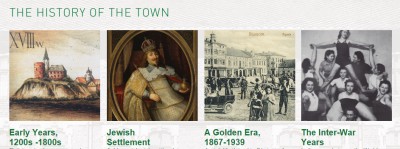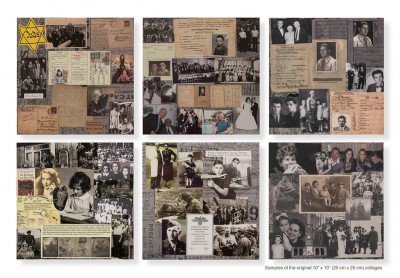Performance Counts: Looking Ahead

Today’s Performance Counts looks ahead. JMM plans its exhibits (both rented and JMM originals) on a two to three year rolling schedule. So while you are enjoying Paul Simon: Words and Music this month we have already locked in our offerings well after 2016’s Beyond Chicken Soup: Jews and Medicine in America. With just one traveling exhibit gallery we try to represent a range of important topics in the Jewish experience – from popular culture to communal tragedies. I have asked Deborah to offer a preview of an important upcoming project.
~Marvin
—————————————————————————————–
In the spring of 2017 we are designing a project that is composed of multiple elements and multiple perspectives. Remembering Auschwitz is comprised of two exhibits, a commemorative art installation and a program series. Our object is to take an international story, well known in its outline, and to bring new focus to the details – by looking at the lives of individuals before, during and after the Holocaust. The project is expected to run from March 5-May 29, 2017, overlapping with the annual Yom HaShoah and 75 years after the camp at Auschwitz became the launching ground for Hitler’s “Final Solution”.
The Feldman gallery will feature two very different exhibits looking at two periods of time A Town Known As Auschwitz: The Life and Death of a Jewish Community comes from the Museum of Jewish Heritage – A Living Memorial to the Holocaust. It explores the history of the Polish and Jewish community that eventually became the site of the notorious camp. The town of Oświęcim—today in Poland—has been known by different names, in different languages, at different times. Though it has a long and varied history prior to World War II, Jews and non-Jews lived side by side in Oświęcim and called it home. This exhibit examines the rich history of Oświęcim, Poland—the town the Germans called Auschwitz—through photographs that trace the life of the town and its Jewish residents, from the 16th century through the post-war period.

A second exhibit, The Auschwitz Album: The Story of a Transport from Yad Vashem interprets the only surviving visual evidence of the process of mass murder at Auschwitz-Birkenau. The Auschwitz Album includes photos that were taken in late May or early June 1944, either by Ernst Hoffman or Bernhard Walter, two SS men assigned to fingerprint and take ID photos of the inmates. The photos portray the arrival of Hungarian Jews from Carpatho-Ruthenia, many of whom came from the Berehov Ghetto, which itself was a collecting point for Jews from several other small towns. The beginning of summer 1944 marked the apex of the deportation of Hungarian Jewry. For this purpose, a special rail line was extended from the railway station outside Auschwitz to a ramp inside the camp. Many of the photos in the album were taken on this ramp. Upon arriving in the camp, the Jews underwent a selection process, carried out by SS doctors and wardens. Those considered fit for work were sent into the camp, where they were registered, deloused, and assigned to barracks. The others were sent to the gas chambers.

These two exhibits will be displayed side by side and will provide visitors with the opportunity to consider the full history of the town and camp. We are planning on supplementing the exhibit with an art installation, Memory Reconstruction: A Sacred Culture Rebuilt, that will serve as a tribute to Maryland’s community of Holocaust survivors and their families. The JMM will work with California-based artist, Lori Shocket, to facilitate an interactive workshop for survivors and their families. During the workshops, participants bring family photographs and documents as well as stories to share with one another. Each survivor’s story is told through a collage printed on birch wood that integrates photos of personal artifacts along with stories. Collages will then be assembled into an art installation in the JMM lobby. Check out the website humanelementproject.com to learn more about this project and to see samples of the installation from The Museum of Tolerance in Los Angeles.

The exhibitions also present us with an abundance of programming opportunities for both school and general audiences. For many years, the JMM has partnered with the Baltimore Jewish Council to facilitate Holocaust-related educational programs for students and teachers and we plan on developing many new educational resources that will help us expand these efforts. We anticipate holding many related public programs including survivor talks, lectures, films and authors talks.
Planning for the exhibitions and programs involves many members of our team. Although these are “rental” exhibits, we still need to develop a design for space, plan for the preparation of the gallery and the handling of artifacts, and work with the project artist on connecting to Baltimore resources. And of course, the most critical part of our planning is raising the funds to support all the activities above and more. Yad Vashem has generously donated the rental of its exhibit thanks to a referral from JMM Board member, Dr. Sheldon Bearman. Still we estimate that the total cost of mounting the exhibits and supporting the programs will be about $50,000. We are working with the Board Development committee to identify community members with a strong interest in supporting this important project.
We know that many of you reading this newsletter appreciate JMM’s commitment to serving as a premiere Holocaust educational venue. If you or anyone you know is interested in learning more about sponsorship opportunities for this project (or any of our upcoming exhibits), please contact me at (410) 732-6400 x236 / dcardin@jewishmuseummd.org.
